Libya, offers a treasure trove of historical and cultural experiences for intrepid travelers. This guide outlines an itinerary that showcases the best of what Libya has to offer, taking you from Roman ruins to ancient Berber settlements.
The coast has Leptis Magna and Sabratha, two UNESCO World Heritage Sites with impressive Roman ruins. Here one can step back in time and wander through ancient theaters, grand marketplaces, and towering arches.
Beyond the Roman influence, Libya also highlights remnants of its colonial past. Italian colonial rule from 1911 to 1951 left its mark on the architecture of Tripoli’s city center. You’ll even find a surprising love for good espresso among the locals – a lingering reminder of the Italian era.

However, this country is not just about coastal cities. The vast desert interior holds hidden gems like Ghadames, an ancient Berber town over 600 kilometers from Tripoli. This UNESCO site features unique mudbrick architecture, a testament to Berber ingenuity in the harsh desert climate. Imagine exploring a town where the very buildings were designed to keep residents cool.
This off the beaten path destination is a real jewel of North Africa. If you are looking to ditch the crowds to experience a genuine expedition into the past, then read on as we share all the pro-tips to keep you engaged and safe.
Map of Libya
This country has many interesting pockets and areas to explore, however, we stuck to the western treasures of Tripoli, Leptis Magna, Gasr-Al-Haj, Kabaw, Ghadames, Nalut Castle and Sabratha. These areas were easily accessible within a 6 day itinerary.
Must Visit Places
This country has over twenty museums filled with treasures, but since the 2011 revolution, most (if not all) have been closed to the public. The Department of Antiquities (DoA) made this difficult decision to protect these valuable collections during a period of unrest. Unfortunately, looting and damage have threatened cultural heritage sites across the country, and the DoA is working to ensure these irreplaceable items are safeguarded until they can be enjoyed by the public again.
We will mention, the main museums to visit in hopes that they will reopen by the time that you visit.
Tripoli
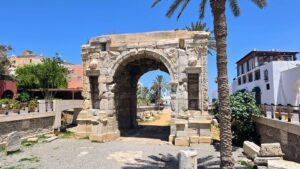
Tripoli, Libya’s capital and largest city, offers a blend of history and modern life. Founded on the edge of the desert along the Mediterranean coast, this city shows off it’s rich past, evident in its historic Old City.
Tripoli’s Old City, an interesting maze of streets and history, offers a glimpse into the city’s past. The basic layout of the Medina, established during Roman times, is surprisingly well-organized, perhaps even surpassing modern urban planning. Built for defense against inland attacks, the city walls, which once surrounded the entire Medina, are still standing and offer stunning views for those willing to climb them. An 8th-century addition expanded the walls to encompass the seafront.
Three gates provided access to the old city: Bab Zanata in the west, Bab Hawara in the southeast, and Bab Al-Bahr in the north. As you explore the Medina’s bustling streets, be sure to check out the Bazaar, a haven for traditional Libyan wares. Here you’ll find everything from jewelry to vibrantly colored clothing.
History buffs won’t want to miss the Museum, housed in the impressive Red Castle. This national museum offers a journey through 5,000 years of Libyan history. Here you will find artifacts from the Roman and Greek periods, including treasures from Leptis Magna and Sabratha. The museum also features exhibits showcasing more recent Libyan history, including a display of the car driven by former leader Muammar Gaddafi. Unfortunately, this museum has been closed since 2011.

Beyond the museums, the Medina boasts a wealth of architectural gems. The Gurgi Mosque, built in 1834, and the Karamanli Mosque are both testaments to Libya’s rich Islamic heritage. And don’t miss the Arch of Marcus Aurelius, the sole surviving Roman monument in the city.
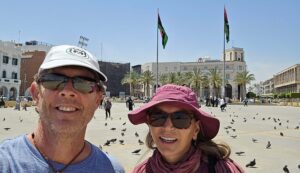
For a contemporary perspective, head to Martyrs’ Square, a popular gathering place offering stunning views of the old city walls. This square is a hub of activity, with shopping streets branching out from it and occasional demonstrations or motorcycle gatherings adding to the vibrant atmosphere. While the square itself may not offer specific sights, it serves as a pulse point for the modern city.
Tripoli’s city-scape offers a poignant mix of history and the scars of recent conflict. Beyond the historic sites, you’ll find sobering reminders of the 2011 civil war. Just outside the Old City stands a skeletal form– the unfinished Intercontinental Hotel, a monument to a project halted by the conflict. The sight of cranes jutting from the abandoned structure is a stark reminder of the war’s disruption.
Similarly, the JW Marriott Hotel tells a story of lost potential. This luxurious skyscraper, overlooking the Mediterranean, was completed just before the war. Imagine the dazzling sight – a brand new hotel with studded lights, offering breathtaking views and jobs to hundreds of people. Unfortunately, the outbreak of war forced its closure, leaving this hotel abandoned and yet another symbol of both Tripoli’s beauty and the challenges it has faced.
Leptis Magna
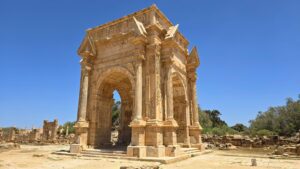
A short journey east from the capital is Leptis Magna, a UNESCO World Heritage Site and one of the most spectacular Roman ruins in North Africa. Imagine towering arches, a vast theater that once accommodated 16,000 spectators, and a grand marketplace, all remnants of a once-thriving Roman city.
Founded by the Phoenicians and later occupied by Carthaginians, this city thrived as a major trade center thanks to its natural harbor. It eventually became a Roman colony and reached its peak under the emperor Septimius Severus, who was born there. During his reign, the city underwent a massive building program, resulting in grand structures like the colonnaded street, the nymphaeum, and the Hunting Baths.

Leptis Magna began to decline in the later centuries of the Roman Empire due to insecurity on the frontiers and economic difficulties. Following the Arab conquest in the 7th century, the city was abandoned and buried by sand until the early 20th century.
Today, archaeological efforts continue to uncover the city’s secrets, revealing the grandeur of its Roman past. The LM Museum and the Al-Saraya Al-Hamra museum hold some of the treasures unearthed at this fascinating site. In addition, there is an onsite museum which displays Leptis Magna’s daily life which includes intricate mosaics and sculptures. Unfortunately all of these museums have also been closed since 2011.
Gasr-Al-Hajj
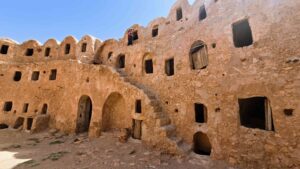
In the Libyan desert, roughly 130 kilometers south of the capital, lies a fascinating historical landmark – Gasr Al-Hajj. This massive, circular structure was built in the 13th century by Abdallah Abu Jatla. Imagine a giant granary, designed to store grain and olive oil for the surrounding communities.
Abu Jatla is said to have offered families storage space in exchange for a quarter of their crops. Interestingly, the original number of chambers – 114 – might have symbolic meaning. It corresponds to the number of chapters (suras) in the Quran, a view popular among local villagers. Today, the number of chambers has grown to 119 due to inheritance disputes, and there are even 29 additional cellars for even more storage.
We were able to see various pieces of pottery that were still intact inside the many chambers of the structure. Rob and our driver Emad had fun climbing beneath the granary only to pop up in a different part of the building.
Gasr Al-Hajj stands as a testament to both the region’s agricultural history and the importance of community support. This unique granary offers a glimpse into a bygone era in this country.
Kabaw
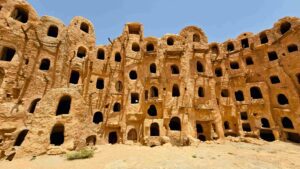
En route to Ghadames, in the Western Mountains of northwestern Libya lies the Kabaw Fort, an interesting piece of history. This circular granary, also known as “Qasr Kabaw” in Arabic is at least 900 years old!
Imagine a giant, round building made of stone, mudbrick, and gypsum, standing 18 meters tall with a diameter of 20 meters. This wasn’t just any structure; it was a crucial storage facility for the local community. Divided into six floors and containing around 360 chambers, the Kabaw Fort served as a giant pantry, keeping dates, oil, figs, wheat, and barley safe for months between harvests.
Security was paramount. Guard rooms at the entrance ensured the community’s precious food reserves were protected from thieves. Individual families each owned a chamber, with roofs constructed from palm trunks and olive branches, covered in a waterproof adobe layer. This ingenious design kept out rodents, insects, and the harsh desert elements, ensuring the safekeeping of the stored food.
The Kabaw Fort is just one example of many such structures scattered across the country. These are testaments to the enduring legacy of the Amazigh people (indigenous people of this area). These circular forts, characteristic of Amazigh architecture, were often built on hilltops or mountains for added security.
Every year in April, the local Spring Qasr Festival celebrates this rich Amazigh heritage, offering a glimpse into the history and traditions of these fascinating people.
Ghadames
Imagine a mirage shimmering in the distance, slowly revealing a breathtaking oasis. Ghadames, emerges from the desert sands, a vision of white architecture fringed by swaying palm trees. The contrast with the golden dunes in the background is simply stunning.
This enchanting desert town isn’t just a feast for the eyes; it’s a cultural gem. The hospitality of the local people is legendary, and experiencing their way of life is an unforgettable memory.
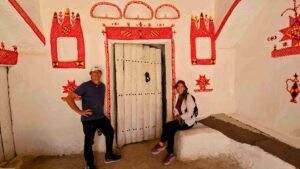
The gem of this city is it’s unique and beautifully preserved Old City. This maze of around 1600 buildings includes over 1250 houses, 21 mosques, and 17 religious colleges located within the 6 neighborhoods of the Old City. While residents have moved to a new development nearby, the Old City remains in use. The original owners cherish their heritage homes and often visit to relax in the gardens or make repairs.
One of the most fascinating aspects of Ghadames is its network of covered alleyways. These pathways often open onto stairwells leading to rooftops, creating a unique interconnected world. Legend has it that these rooftop gardens were once the exclusive domain of the women, offering them a hidden vantage point to observe the men below!
A visit here wouldn’t be complete without exploring some of its hidden gems. Make sure that your guide takes you to the Tojada Cafe, located within a traditional mudbrick house where you will enjoy traditional tea with almonds and the lovely garden of the cafe.

Nearby we were taken to an old traditional home filled with vibrant murals adorning the walls, and intricately hand-woven carpets covering the floors. Family heirlooms, like a seven-foot rifle, old brass coffee pots, and ancestral artwork, offer a glimpse into the lives of past generations. Here, in this traditional home, we enjoyed a special lunch made for us by the Tojada Cafe. An absolutely delicious couscous with Camel meat for everyone and of course without (vegan style) for me.
History buffs will appreciate the ornate palm doors adorned with brass scattered throughout the Old City. Each one is a piece of art, adding to the city’s charm. In addition, palm doors decorated with round yellow, green and red circles indicated that the man inside the dwelling had successfully traveled to Mecca.
Be sure to take a look at the soaring white minarets of the Omran and Yunnis Mosques, architectural marvels that stand out from the rest. While entry isn’t permitted, we appreciated their beauty from the outside.

On our last night in town, we embarked on an unforgettable adventure – a 4×4 excursion through the desert dunes bordering Tunisia and Algeria! An experienced driver picked us up in a sturdy 4×4 truck and whisked us away for a thrilling ride. We climbed some of the area’s highest dunes, enjoying breathtaking views of the neighboring countries as we ascended.
The highlight? Witnessing a magical sunset from the top of the dunes. As the sun dipped below the horizon, painting the sky in vibrant colors, we made our way back down. At the base of the dunes, the local Touareg people welcomed us with a taste of their culture. They cooked traditional Touareg bread right in the sand, paired with a steaming cup of their traditional tea. Under a canopy of a million twinkling stars, we savored the delicious meal and the magical atmosphere. It was a truly unforgettable night!
Nalut Village and the Nalut Old Castle

Located in Libya’s Nafusa Mountains, Nalut is a Berber town steeped in history and natural beauty. Located about 270 kilometers southeast of Tripoli and roughly 610 meters above sea level, Nalut offers stunning scenery and a glimpse into the past.
Nalut’s strategic location made it a key stop on ancient trade routes. Today, it’s a popular stop for tourists traveling between Nalut and the desert oasis of Ghadames. Here, you’ll find some of the best-preserved Berber granaries and castles in Libya, including the Nalut Old Castle which has nearly 400 rooms and once served as a communal storage space for local families during times of conflict.
Imagine an “ancient Berber bank” where people could store grain, oil, and other produce for safekeeping. The rectangular building sits on a steep hillside, surrounded by the remnants of an old village. Its exact age is unknown, with estimates ranging from 1240 AD to a much older 2,000 years.
This fascinating granary is a marvel of design. Instead of stairs, there are small wooden pegs embedded in the walls that people would climb to access the hundreds of rooms stacked on five or six floors. Each room was about 1.5 meters wide and tall and could hold enough food to sustain a family for a year. Large jars for olive oil were also stored inside.
You can also explore the surrounding area and discover the ruins of old villages and settlements waiting to be unearthed. There are several natural springs in Nalut, which include Tala and Touneen. These springs provide a refreshing escape, while the numerous ancient ruins scattered around the city hint at Nalut’s long and fascinating history.
In addition, Nalut is an archaeologist’s dream. Libya, in general, has seen very little excavation, and Nalut is no exception. With dinosaur fossils recently discovered nearby, the potential for unearthing more about the region’s history is immense.
If you’re looking for a cultural experience, don’t miss the Nalut Spring Festival. This vibrant celebration promotes the local Berber culture, traditions, and art, solidifying its place as a cherished part of Libya’s heritage.
Sabratha

Sabratha, is another UNESCO World Heritage Site located 74 km west of the capital. This city, founded by the Phoenicians and later occupied by Carthaginians, thrived as a major trade center thanks to its natural harbor.
It eventually became a Roman colony and reached its peak under the emperor Septimius Severus, who was born there. During his reign, the city underwent a massive building program, resulting in grand structures like the colonnaded street, the nymphaeum, and the Hunting Baths.
Sabratha, a sister city to Leptis Magna, offers another glimpse into Roman grandeur, but with a distinct character. While Leptis Magna boasts a scale and completeness that rivals Rome itself, Sabratha offers a more intimate and elegant feel.
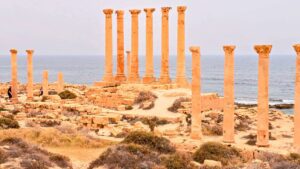
Explore the well-preserved Roman theater, forum, and temples, remnants of a glorious past. Sabratha’s theater, built in the 2nd century AD, is particularly impressive and is still occasionally used for performances today. Imagine experiencing a play or concert under the same sky that entertained audiences almost 2,000 years ago! This beautifully preserved theater is considered one of the best-preserved Roman theaters in North Africa.
Another highlight is the Temple of Hercules, constructed in the 2nd century AD and dedicated to the Roman god of strength and doorways. This impressive structure stands on a podium and features six massive granite columns.
Don’t miss the well-preserved forum, the central square that was the heart of Roman public life. Here, citizens would gather to conduct business, socialize, and participate in government affairs. The forum at Sabratha is surrounded by the remains of shops, temples, and other important buildings.
Sabratha is a fascinating open-air museum, offering a glimpse into the Roman world. While smaller than Leptis, its well-preserved buildings and ongoing archaeological excavations make it a must-see for any visitor to this country.
Logistics – How to Plan your Trip
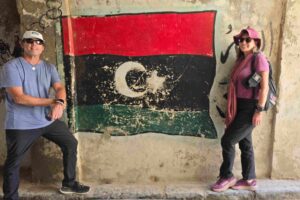
While Libya is becoming increasingly accessible, some pre-trip planning is essential. The new e-visa system simplifies the process, but researching visa requirements and documentation is crucial. In our opinion, hiring a guide is highly recommended.
The best time to visit depends on your preferences. Spring and autumn offer pleasant temperatures, while summer can be scorching, especially in the Sahara. The winter months can be mild along the coast but get colder in the mountains. Be sure to pack for the climate you’ll encounter and remember that modest clothing is recommended, especially in more conservative areas.
Libya awaits the adventurous traveler seeking an unforgettable experience. From the majestic Sahara Desert to the captivating Roman ruins and the rich Berber culture, this North African nation promises an adventure unlike any other. So, pack your bags, embrace the unexpected, and embark on a journey to discover the magic of this country!
SAFETY
When we visited and at the time of writing, all travel advisories (Canada, USA, Australia, etc.,) where at the highest level – Do Not Travel. This is due to the potential risk of terrorism and kidnapping in this country. We were aware of this and made a conscious decision based on the information that we had from our guide, trusted news channels and our tolerance for risk.
I mean hey, we have visited the DRC, Burkina Faso, Central African Republic of the Congo, Afghanistan, Myanmar, Mali, Sudan, South Sudan and some other risky places. All of these quests were based on deep research, conversations with people on the ground balanced with our sense for adventure.
Ultimately, the decision to travel here (or to any other potentially risky travel destination) rests with you and your personal tolerance for risk.
CURRENCY
This country uses the Libyan Dinar (LYD) as currency, however, the USD or Euro is the money that most people want to receive for bigger purchases. The official exchange rate is a fraction of the one you can get from the black market exchange, located inside the main airport. We were able to get 690 LYD for $100 USD.
You may do even better with an exchange at the proper black market, which is located immediately behind the art-deco headquarters of the Central Bank of Libya (CBL) on the edge of Tripoli’s Old City. However, this exchange is recommended with a local as the site is pretty intimidating with hundreds of traders doing exchanges.
PRO TIP: Do your exchange in the capital prior to traveling to smaller cities, as the exchange there is not as good.
TOURIST VISA
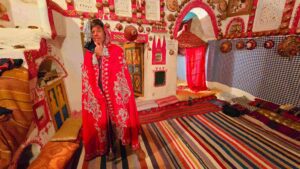
Traveling to Libya just got easier with the new eVisa program! The eVisa program allows you to apply for a visa online and stay in the country for up to 90 days within a six-month period. It is available for tourist, business and transit purposes. To obtain an eVisa, you need to fill out an online application form with personal details, travel, itinerary, sponsor information and accommodation information.
Your guide will act as a local sponsor. If you wish to travel independently, you may be able to get a local friend to sponsor you. However, bear in mind that whomever you list as your sponsor will need to pick you up from the airport and fully vouch for you.
In addition, the Libyan Tourism Police will assign a Tourist Police officer to travel with you wherever you go. Our guide (Abu Baker, see below) arranged for his favorite Tourist Police Officer to travel with us.
Therefore in the car we had our driver and police officer sitting in the front, we sat in the middle row and Abu Baker sat behind us. Very unusual situation, but it worked and we even found the police officer to be pleasant and helpful (although he did not speak any English).
CONNECTIVITY: SIM/ESIM CARDS
There are only 2 real options for mobile phone companies here: Al Madar and Libyana. Many Libyans actually carry 2 SIM cards, one for each company. Currently you can purchase a new SIM card for 5 LYD from each of these companies. We purchased the Libyana SIM card from a small kiosk in the airport. It worked well in the cities, however was quite spotty outside of the capital.
LIBYAN GUIDE/DRIVER
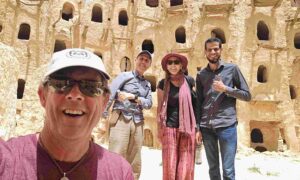
We were very lucky to travel through this country with the countries #1 guide! Abu Baker of Wadi Smalos and Emad (our driver). The staff of Wadi Smalos are kind, informative and incredibly thoughtful. They made our tour one of our favorite in the world and we can’t recommend them enough! Traveling with Abu Baker and Emad is worth every penny.
What’s App: +218 91 363 3082 Email: [email protected]
TRANSPORTATION
The country had a wonderful railway system, prior to Gaddafi’s decision to dismantle it during his reign. Since 1998, the country has been planning to restart the railroad system, but the 2011 Civil war put a stop to all of that progress. However, the roads in Libya are surprisingly good. Fuel is the second cheapest in the world after Venezuela and costs less than water – when you can find it.
Transportation here is limited to buses and taxis. There are 3 airports that are still in operation: Tripoli, Benghazi and Sabha. We highly recommend traveling with your guide/driver as there are many checkpoints and travel without a sponsor can be difficult if not impossible. In addition, outside of the capital, fuel may be difficult to find without knowing people along the way who can provide it at black market prices.
Wrap Up
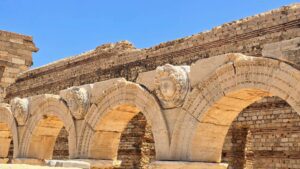
Libya offers a surprising wealth of history for adventurous travelers. It provides a glimpse into a rich history, from ancient Roman ruins to Berber settlements carved into cliffs. And of course the glory and beauty of Ghadames cannot be missed.
We knew that most travel advisories discouraged visiting this country. But honestly, we felt safe throughout the entire trip. We had a tourist police officer with us, regular checkpoints, and military oversight. Plus, our amazing guide and driver made us feel completely secure. We enjoyed our trip so much with the Wadi Smalos team that we’re already talking to Abu Baker about going back to explore the eastern and southern parts of the country!
Have you traveled to Libya or any of the other North African countries? Do you have any questions for us? Please do go ahead and let us know in the comments. We would love to answer any questions that you may have.

